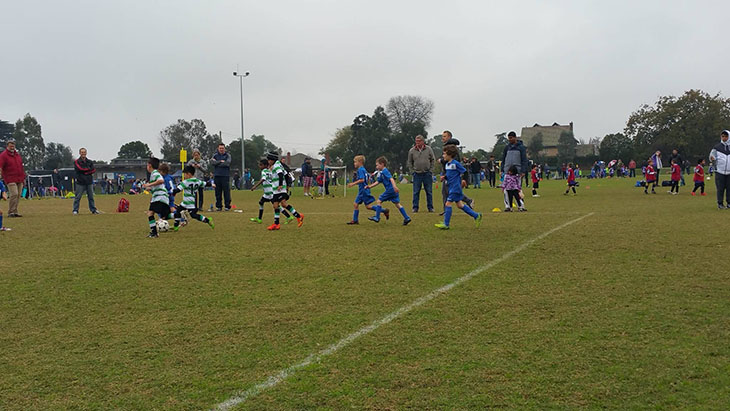Photo: Football Federation Victoria
Much has been written about the best system of development to produce world class football players. The debate rages on in Australia but the issue isn’t being properly framed.
Former Socceroos captain and current Central Coast Mariners head coach Paul Okon opened up on the issue while speaking on the Daily Football Show in December:
“It really frustrates me, because we have more accredited coaches, more academies, we are certainly full of opportunities for kids these days, it’s all there for them, but from the ages of six, seven, eight, nine and 10, if you don’t sleep with the ball, if you don’t have the ball at your feet every day, it doesn’t matter what SAP program you go into. It doesn’t matter what coach your going to have at age 12, 13, 14 – if you have not developed that connection with the ball at a younger age, you’re going to produce players but players at what level?”
Contrary to popular narrative, no academy, club or program singularly “produces” players. Neither does a single coach. Let’s make this very clear: top academies or youth development programs pick up players who are already good then give them a chance to play against and train with other good players, usually with educated coaches and nice facilities. Most of these programs have armies of local and international scouts, feeder clubs and trials in order to identify what they deem to be the best available talent.
Instead of saying they “produce” players, the word we should use to describe what these programs and clubs actually do is “refine”. They do not turn beginners into superstars with a magical set of training exercises unique to them or their coaching staff. They may touch up areas of a player’s game, behaviour or professionalism and give them access to additional knowledge and experience but the fact is that usually the player already has some level of ability upon being invited or selected into the program.
The two most important factors in the development of any person are their environment and their “why?”. What pressures and situations have they faced? What problems have they solved? What are their constraints? Who are they learning from or competing against? Where and when does their learning take place? Why do they do what they do? What motivates them to get better?
Interestingly, despite all the talk of academies and programs being solely responsible for developing players or their style of play, often when you watch videos of world class players as kids they display extremely similiar characteristics to the “finished product”. Where did they learn to play that way?
The best players – I’m talking about the actual match winners in football, not just the good professionals – are usually found to have developed their skill and hunger in adverse conditions as young children, typically on the street or park and in poverty. Alexis Sanchez, Luis Suarez, Zlatan Ibrahimovic, Ronaldinho, Zinedine Zidane, Ronaldo. These are the most exciting and expensive footballers in the world and their narrative is always very similiar according to Arsene Wenger:
“If we look across Europe and the world of football, then South America is the only continent to develop strikers today. You will see that at least 80% come from South America…Maybe in our history street football has gone. In street football when you are a 10-year-old, you play with 15-year-olds so you have to be shrewd, you have to show that you are good, you have to fight to win impossible balls.”
The bottom line is that these kids, who grew up to be the most revered footballers on the planet, played countless hours of unstructured football. Organized club or program football is great and certainly serves an important purpose but it is always run by adults and therein lies the problem. In such an environment, the child usually has to conform to the adult’s vision of the game. There is usually no room for individualism or creative expression, despite the protests of many a coach who will tell you that they love playing “good football” and “developing creating players”. I’ve done it myself!
Furthermore, people now rely on organized football far too much to develop skill. The reality of these programs is usually that a child will train two-three times per week plus a game. This equates to roughly five-six hours of football a week. Great strides have been made, especially in Australia, to ensure that these limited football hours are spent more wisely.
Increased touches of the ball and less time spent on non-football activities and good coaches can help a player to identify where they need to improve. However, if you seriously think that such a small amount of practice will allow a coach or program to address each individual and turn anybody into a world class player then I’m afraid you are gravely mistaken.
Wenger continues, arguing that:
“When it is all a bit more formulated then it is less about developing your individual skill, your fighting attitude. We have lost that little bit in football. Society has changed. We are much more protected than we were 30 years ago. We have all changed. We have all become a bit softer.”
Closer to home, Paul Okon agrees with the Arsenal boss, explaining that:
“If you’re only going to go training two nights a week for an hour and a half, and in-between you don’t connect with the ball, then you’re going to struggle to develop at the level we need our players to be developing.”
There is a sad lack of children playing football – or any sport for that matter – in the streets or in our local parks. The reasons for that are complex but come back to environment. Aside from the increase in fear-mongering media reports in recent years, kids do not have a “why?”. There isn’t a strong enough reason for them to put down the PlayStation controller and leave their air-conditioned couch throne in the middle of summer to go outside and play with a ball. And it’s beginning to show.
Recently, I have overseen multiple sets of trials at the skill acquisition level (under 13 and below). Many kids are able to show decent enough technique in isolation or under no pressure but in the heat of a game in small spaces are often unbalanced and fall over easily, have poor running technique, can’t change direction quickly – with and without the ball – or evade and struggle to jump and contest loose balls.
No program can adequately develop those motor skills under pressure. When kids play outside in an unstructured environment they often run, climb, jump, land, fall, balance, tumble, dodge, push, pull, contest, battle, compete, learn gamesmanship or cunning and adapt to different surfaces.
It’s not just the motor skills either, it’s the social skills required for team sports. Critically, when playing unstructured games, kids will invent their own variations or rules, negotiate, argue, mediate, come to agreements and learn to identify social cues. This becomes a lot more difficult if there is always an adult present or in charge who comes up with the rules and enforces them.
Most importantly, unstructured football gives kids an opportunity to spend time and connect with the ball on their own terms, not dictated by the opinions or knowledge of a coach or adult. It becomes a mixture of isolated and game-based training where players find their own ways of manipulating the ball to deal with their environment, helping to develop skill that is often unique to them.
In an unstructured scenario, a child may try to emulate a favourite player or mix the styles of multiple players, respond to their own specific set of pressures or difficulties – like competing against older, bigger or better skilled kids – or invent their own methods and solutions to problems that nobody has ever seen before! In doing it themselves, they develop a greater love and feel for the ball.
Paul Okon has a final say and offers some advice on the matter:
“I have four sons of my own, I have two that play football, so I’m at local football grounds for 52 weeks of the year. I have parents approach me and ask what the best pathway is for their son. The role and the responsibilities of parents at that age is not to worry about where they’re going to be playing in Europe, it’s to make sure they can create that football culture inherent where their child is going to want to have a ball at their feet every day. Only then are they going to have a real opportunity to get to that level, if not then we’re going to continue down the road where were struggling to develop young players.”
So then, the question we should be asking is: How can we as coaches, football administrators and supporters help to create a culture where kids love the ball, admire and appreciate great players (local and international) and have a burning desire to go and practice on their own, away from training, to try to become the very best?
The first step is to give the kids back their game!
Originally published on rmarchioli.wordpress.com.

